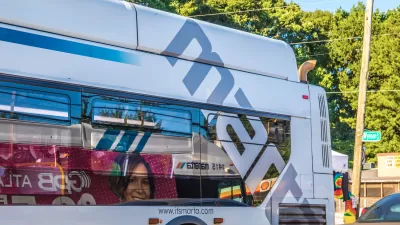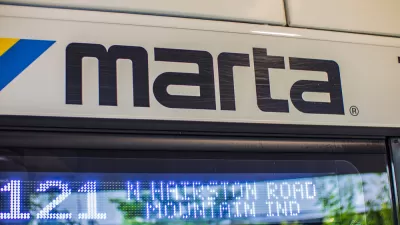Officials in the city of Atlanta are planning a groundbreaking ceremony this week for the Metropolitan Atlanta Rapid Transit Authority’s first bus rapid transit line.

Officials from Metropolitan Atlanta Rapid Transit Authority (MARTA) and the city of Atlanta will gather later this week for a ceremony to commemorate the groundbreaking on a new bus rapid transit (BRT) route—the first in the city.
“The five-mile BRT route—MARTA’s first new transit line since the Sandy Springs MARTA station opened in the year 2000—will link downtown to neighborhoods such as Summerhill and Peoplestown before ending near the BeltLine’s Southside Trail. Along the way will be connections to MARTA’s heavy rail system at Five Points, Georgia State, and Garnett Stations,” according to an article by Josh Green for Urbanize Atlanta.
“The region’s first BRT line, according to MARTA officials, will operate with new electric buses. About 85 percent of the corridor will have dedicated bus-only lanes with transit-signal priority, meaning buses shouldn’t be bogged down in traffic and that travel times should be quicker,” adds Green.
As noted in the article, the project has been delayed from an originally scheduled 2022 groundbreaking date. According to Green, “the project was dogged by skyrocketing building and labor costs, in addition to MARTA’s inexperience with creating new transit lines over the past two decades.”
Previous Planetizen coverage of Atlanta’s BRT plans:
- Atlanta Proposed Rail Line to Become Bus Rapid Transit (February 2023)
- MARTA Reveals Renderings for Bus Rapid Transit Stops (March 2023)
- Atlanta Gaining Two New ‘Arterial Rapid Transit’ Lines (April 2023)
- What Is ‘Arterial Rapid Transit?’ (June 2023)
More project details, including renderings of planned stations and a system map, can be found at the link below.
FULL STORY: Atlanta's first bus-rapid transit line finally set to break ground

Maui's Vacation Rental Debate Turns Ugly
Verbal attacks, misinformation campaigns and fistfights plague a high-stakes debate to convert thousands of vacation rentals into long-term housing.

Planetizen Federal Action Tracker
A weekly monitor of how Trump’s orders and actions are impacting planners and planning in America.

In Urban Planning, AI Prompting Could be the New Design Thinking
Creativity has long been key to great urban design. What if we see AI as our new creative partner?

King County Supportive Housing Program Offers Hope for Unhoused Residents
The county is taking a ‘Housing First’ approach that prioritizes getting people into housing, then offering wraparound supportive services.

Researchers Use AI to Get Clearer Picture of US Housing
Analysts are using artificial intelligence to supercharge their research by allowing them to comb through data faster. Though these AI tools can be error prone, they save time and housing researchers are optimistic about the future.

Making Shared Micromobility More Inclusive
Cities and shared mobility system operators can do more to include people with disabilities in planning and operations, per a new report.
Urban Design for Planners 1: Software Tools
This six-course series explores essential urban design concepts using open source software and equips planners with the tools they need to participate fully in the urban design process.
Planning for Universal Design
Learn the tools for implementing Universal Design in planning regulations.
planning NEXT
Appalachian Highlands Housing Partners
Mpact (founded as Rail~Volution)
City of Camden Redevelopment Agency
City of Astoria
City of Portland
City of Laramie





























